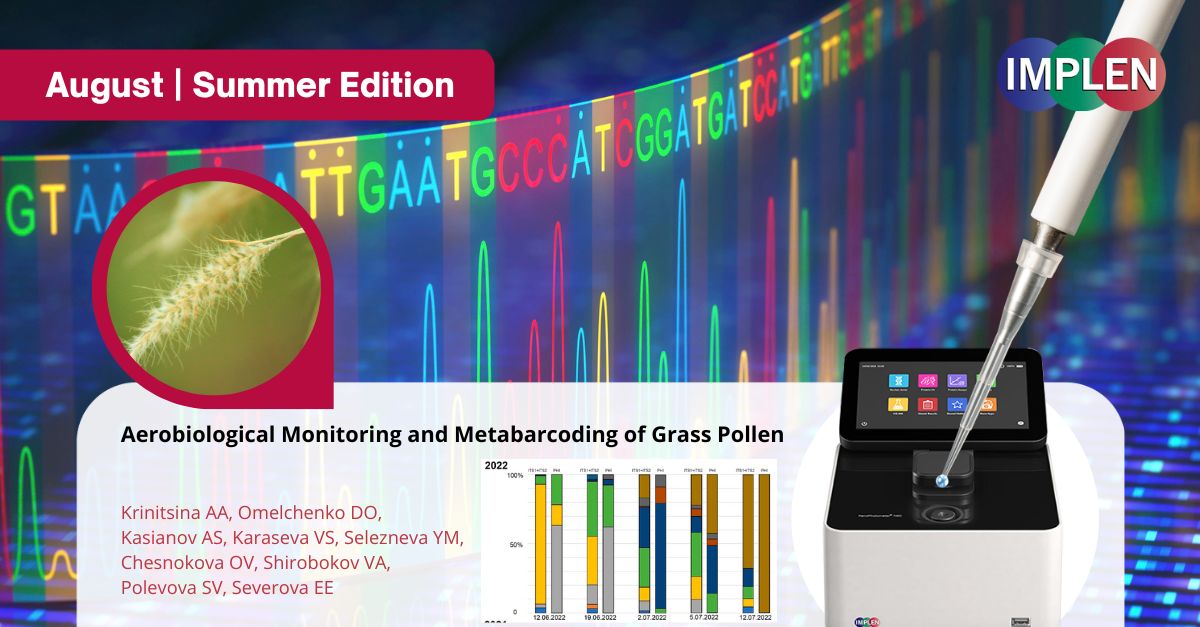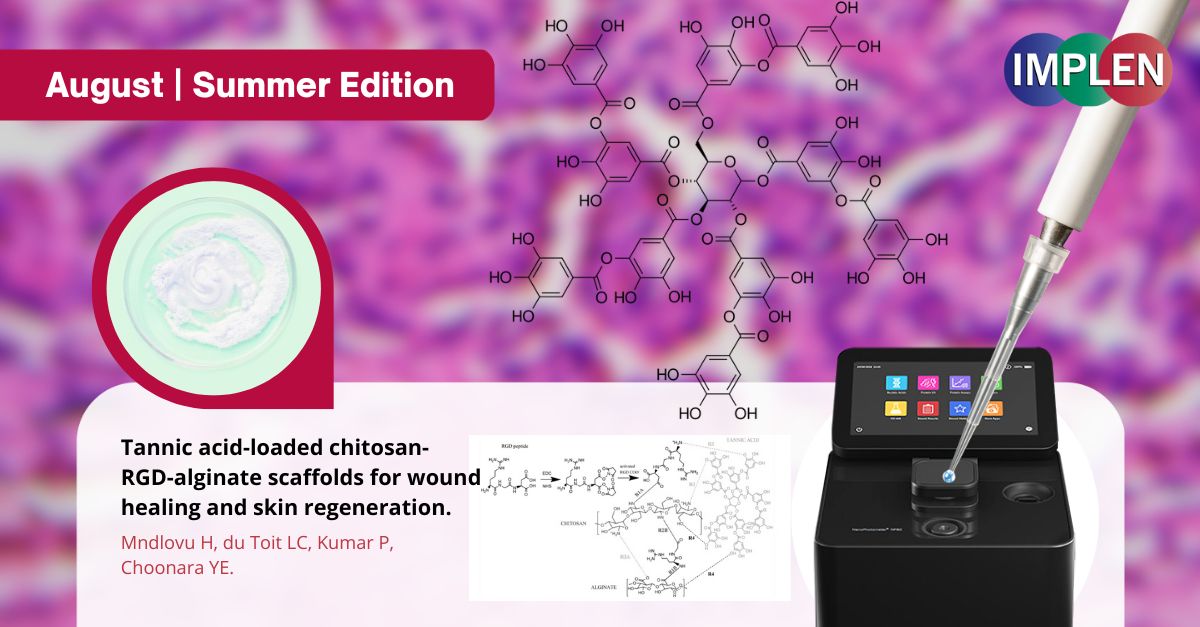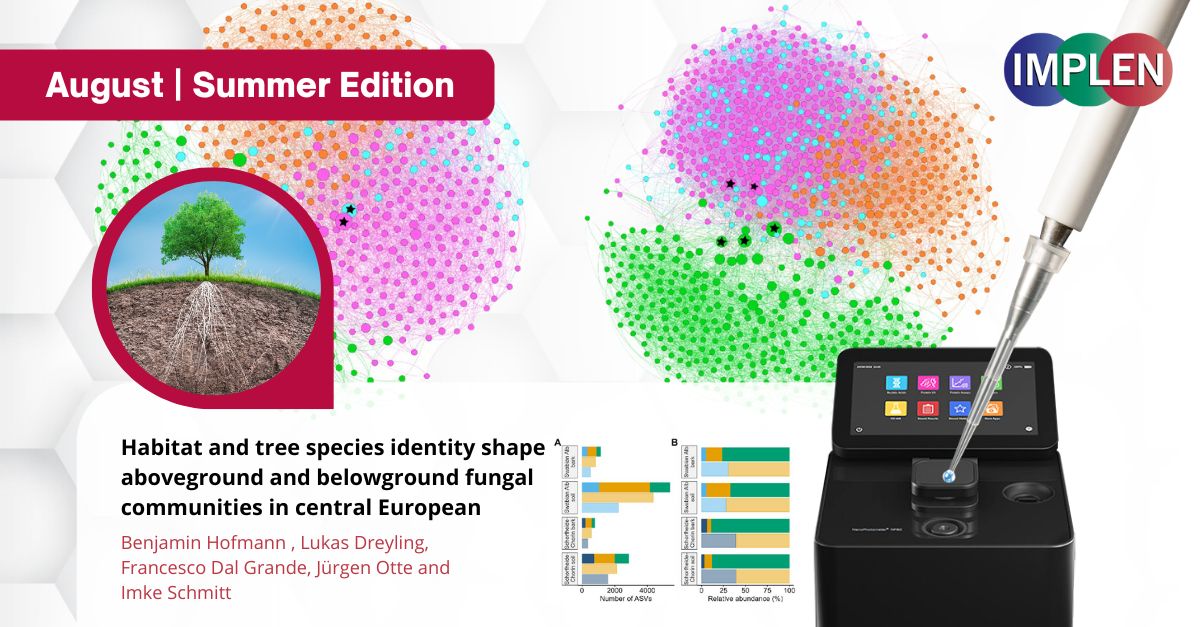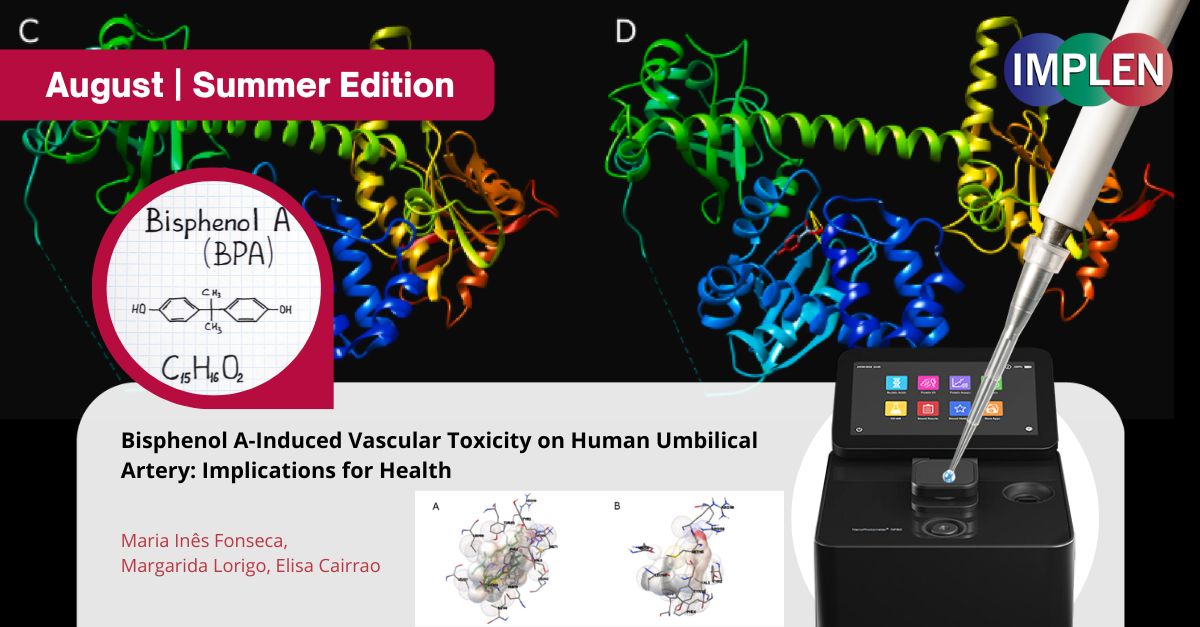Implen Journal Club | August Issue Summer Edition |
|
The first issue of Implen NanoPhotometer® Journal Club: Summer Edition, highlights an exciting study published by Krinitsina et al. in the journal of Plants, which delves into the fascinating world of aerobiological monitoring and metabarcoding of grass pollen. As a major environmental allergen, grass pollen is responsible for seasonal allergic rhinitis and asthma in millions worldwide. By examining its genetic makeup, the study offers crucial insights into factors influencing allergenicity and allergen exposure patterns. Beyond its impact on public health, this research carries significant implications for understanding ecosystem dynamics. Grasses, as primary producers and key components of food chains in terrestrial ecosystems, play a vital role. By studying their pollen distribution and genetic diversity, we deepen our understanding of plant reproduction, gene flow, and species interactions within ecosystems. This study employed metabarcoding, an advanced genetic sequencing technique, to analyze the diversity of multiple grass species' pollen simultaneously. This revolutionary approach enables a comprehensive assessment of species diversity and seasonal variations, transforming the study of airborne pollen. These research findings have significant practical implications across various domains, particularly in allergy management. Identifying dominant allergenic grass species in the air aids healthcare professionals in developing targeted treatment plans and pollen forecasts, empowering patients to better cope with peak pollen seasons. Moreover, ecological studies stand to benefit from understanding pollen dynamics, providing insights into plant community composition, ecological interactions, and biodiversity conservation. The genetic diversity of grass pollen also provides valuable information about plant adaptation and potential responses to environmental changes. This study represents a significant contribution to the field of aerobiology, serving as a stepping stone for future research on grass pollen monitoring and genetic diversity assessment providing valuable insights into both environmental dynamics and the understanding and management of allergies. The NanoPhotometer® N60 was used to assess the purity of the DNA samples according to the A260/280, and A260/230 ratios. |
|
In the second issue, we are sharing exciting research that could be useful in the future for first aid kits for summer outdoor activities. Mndlovu et al. recently published in the journal of Biomedical Materials groundbreaking progress in the field of wound healing and skin regeneration with the development of tannic acid-loaded hydrogels. Wound healing is a complex biological process that involves a series of intricate cellular and molecular events to restore the integrity and function of damaged tissues. The creation of scaffolds has emerged as a promising approach in tissue engineering and regenerative medicine, providing a temporary three-dimensional framework to facilitate cell adhesion, migration, proliferation, and differentiation. Chitosan, derived from crustacean shells, has drawn significant attention due to its biocompatibility and biodegradability, making it an ideal scaffold material. In this study, chitosan was combined with RGD peptide and alginate, which enhanced the scaffold's bioactivity and mechanical strength. Moreover, the incorporation of tannic acid, a natural polyphenol known for its antioxidant and anti-inflammatory properties, further enhanced the scaffold's potential for wound healing. This work evaluated the scaffolds' biocompatibility and the release profile of tannic acid. Remarkably, the results demonstrated that the scaffolds not only supported the adhesion and proliferation of skin cells but also showed a sustained release of tannic acid, offering prolonged therapeutic effects to expedite the wound healing process. The results exhibited significant improvements in wound closure and tissue regeneration, further validating the potential clinical relevance of these novel biomaterials in the management of various wound healing challenges. This groundbreaking research paves the way for advanced wound care and tissue engineering applications, offering hope for more effective medical treatments in the near future. The NanoPhotometer® NP80 was used in this study to measure tannic acid concentration as well as the amount of tannic acid encapsulated in the scaffold and released at predetermined time points. |
|
The next issue is highlighting the research study "Habitat and tree species identity shape aboveground and belowground fungal communities in central European forests" conducted by Hofmann et. al. exploring the impact of habitat characteristics and tree species identity on the composition of fungal communities in central European forests. Forests play a crucial role in supporting biodiversity, and their ecological functions are greatly influenced by belowground interactions, particularly involving fungi. Fungi form symbiotic relationships with trees, aiding in nutrient uptake and enhancing their resilience to environmental stresses. Soil and root samples were collected from various central European forests, spanning different habitat types and tree species and the DNA was analyzed to identify and compare the fungal communities present in the aboveground foliage and the belowground soil and roots. The results revealed that both habitat type and tree species identity significantly impact the diversity and composition of fungal communities. Different habitats, such as mixed deciduous forests, coniferous forests, and beech-dominated forests, exhibited distinct fungal profiles. Furthermore, the type of tree species present had a substantial effect on the fungal community associated with their roots and surrounding soil. These findings highlight the importance of considering both aboveground and belowground factors when studying forest ecosystems. The interplay between tree species and their associated fungal communities plays a critical role in shaping the overall ecological dynamics of the forest. Understanding these relationships may aid in forest management and conservation efforts, as well as provide insights into how ecosystems may respond to environmental changes. By shedding light on the factors that influence fungal communities, this work offers valuable information for designing effective strategies for maintaining and promoting biodiversity and ecosystem stability in central European forests. The NanoPhotometer® was used in this study to quantify the DNA in the soil and root samples. |
|
In the final issue,highlighting the work to better understand the potential risks posed by bisphenol A (BPA) on human health. Maria Inês Fonseca et al. conducted a significant study recently published in Environmental Research with their attention directed to the human umbilical artery, a pivotal conduit in fetal development and vascular physiology. Given the concerns surrounding BPA's disruptive effects on hormones and health, investigating its impact on a critical vascular structure was of paramount importance. The study aimed to evaluate BPA-induced vascular toxicity on the human umbilical artery, shedding light on potential health implications. The researchers employed a comprehensive approach involving experimentation and analysis. By elucidating the effects of BPA on this specific artery, the study aimed to contribute to a broader understanding of cardiovascular health. The findings of the study provide crucial insights into the potential risks of BPA exposure on vascular health. The research establishes a link between BPA exposure and adverse vascular effects, offering a glimpse into the broader repercussions for both prenatal and adult health. These findings underscore the significance of considering environmental factors in health assessments and policy-making. The study holds relevance in the context of growing concerns about the impact of environmental chemicals on human health. By highlighting the potential risks of BPA exposure on vascular health, this work contributes to informed decision-making and the formulation of protective measures to mitigate these risks. This research bridges the gap between environmental exposure and physiological consequences, fostering a better understanding of the intricate relationship between chemicals and human health. The NanoPhotometer® was used in this study to assess the quantity of RNA. The NanoPhotometer® was used in this study to quantify the DNA extracted from the opium plant leaves. |
|
In the final issue, we is delving into the realm of biotechnology, with a groundbreaking study by Vogel et. al. which focused on leveraging the potential of Cell-Penetrating Peptides (CPPs) for delivering dsRNA and siRNA to the resilient Desert Locust, Schistocerca gregaria, that holds the promise of revolutionizing pest control strategies. The Desert Locust, notorious for its swarming behavior and devastating impact on agriculture, has posed significant challenges for effective control measures. Traditional chemical pesticides raise concerns about environmental safety and sustainability. In this context, the exploration of alternative methods like RNA interference (RNAi) presents a ray of hope. The study examines the utilization of CPPs as carriers to facilitate the ingestion of dsRNA and siRNA molecules by the locusts, leading to targeted gene silencing. What makes this research particularly captivating is its potential to pave the way for eco-friendly and species-specific pest management. By harnessing the natural biological processes of the locusts themselves, the approach minimizes collateral damage to non-target organisms and the environment. Furthermore, it aligns with the growing global emphasis on sustainable agricultural practices and reduced reliance on conventional pesticides. The implications of this study extend beyond the realm of pest control. Successful implementation could unravel new avenues for the application of CPPs in the field of functional genomics, gene therapy, and beyond. As the findings hold the promise of reshaping established paradigms, they also underscore the dynamic interplay between biotechnology and ecological harmony. The NanoPhotometer® N60 was used to determine CPP concentration. In addition the N60 was used to assess fluorescence labeled dsDNA integrity, concentration, and labeling efficiency. The NanoPhotometer® was used in this study to quantify the DNA extracted from the opium plant leaves. |
©2023 Implen. All rights reserved.



